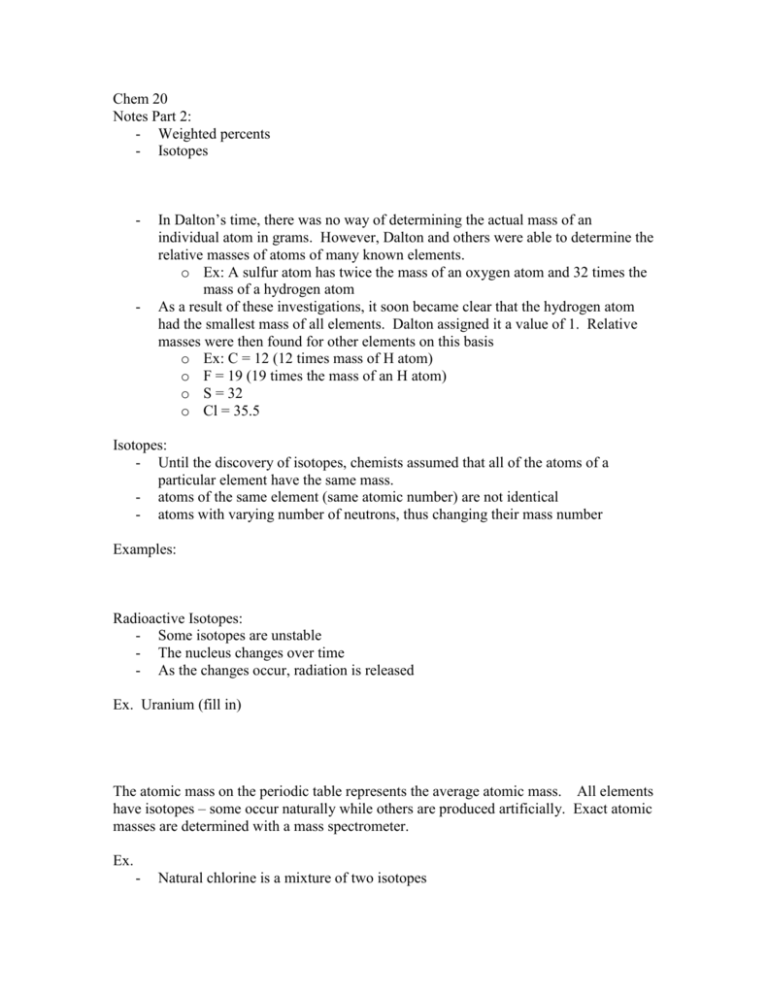Chem 20 - FW Johnson Collegiate
advertisement

Chem 20 Notes Part 2: - Weighted percents - Isotopes - - In Dalton’s time, there was no way of determining the actual mass of an individual atom in grams. However, Dalton and others were able to determine the relative masses of atoms of many known elements. o Ex: A sulfur atom has twice the mass of an oxygen atom and 32 times the mass of a hydrogen atom As a result of these investigations, it soon became clear that the hydrogen atom had the smallest mass of all elements. Dalton assigned it a value of 1. Relative masses were then found for other elements on this basis o Ex: C = 12 (12 times mass of H atom) o F = 19 (19 times the mass of an H atom) o S = 32 o Cl = 35.5 Isotopes: - Until the discovery of isotopes, chemists assumed that all of the atoms of a particular element have the same mass. - atoms of the same element (same atomic number) are not identical - atoms with varying number of neutrons, thus changing their mass number Examples: Radioactive Isotopes: - Some isotopes are unstable - The nucleus changes over time - As the changes occur, radiation is released Ex. Uranium (fill in) The atomic mass on the periodic table represents the average atomic mass. All elements have isotopes – some occur naturally while others are produced artificially. Exact atomic masses are determined with a mass spectrometer. Ex. - Natural chlorine is a mixture of two isotopes Isotopes: Atoms with varying masses 35 Cl = 75% 37 Cl = 25% The average atomic mass of this mixture is 35.5 and this is what the chemists were measuring in the 19th century. - The atomic mass listed for each element in the periodic table is the average value for the mixture of isotopes in a natural sample of the element. The unit of measurement is often given as amu or μ Example: Determination of Report Card Mark Billy’s Marks are as follows: Final Worth: 30% Homework Worth: 10% Assignments worth: 15% Term Tests Worth: 30% Labs Worth: 15% Final: 82% Homework: 8% Assignments: 67% Term tests: 73% Labs: 75% What is Billy’s final mark? Solution 1. Change all ‘weighing’ marks into their decimal form Final: .30 Homework: 0.10 Assignments: 0.15 Tests: 0.30 Labs: 0.15 2. Multiply Billy’s Mark by the weight decimal Final: 82% x 0.30 = Homework: 8% x 0.10 = Assignments: 67% x 0.15 = Tests: 73% x 0.30 = Labs: 75% x 0.15 = Add up all the results to get the weighted averages. The same process can be used for determining atomic masses Isotope Potassium – 39 Potassium – 41 Relative Abundance 93.12% 6.88% Atomic Mass of Isotope 38.964amu 40.962amu Work through solution!! Activity: Atomic Mass of Noodilium Question Sheet






